NJ (908) 688-5577
NY (212) 737-2528
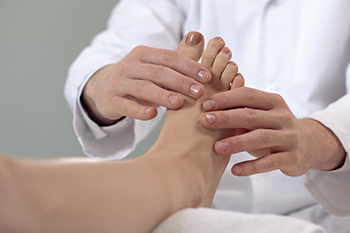
The ankle is a complex system of bones, tendons, and muscles that connect the leg and the foot. If any one of those elements is compromised, it may result in pain whenever you take a step. If you spend a lot of time running, walking or jumping, some type of pain in the ankle is not uncommon. Most ankle pain is the result of an injury to a muscle, tendon, or ligament. Ankle pain may also be caused by medical conditions, including arthritis, gout, or peripheral neuropathy. An injury, such as a ligament sprain, a muscle strain, or a fractured bone, will likely cause ankle pain and inhibit your ability to walk normally. Pain in the back of the ankle may be connected to an injury of the Achilles tendon. This can become torn, ruptured or inflamed, and severe cases may prevent you from putting any weight on the foot. If you are experiencing ankle pain when you walk, it is a good idea to consult a podiatrist for an exam and a diagnosis. An appropriate treatment plan can then be put into action.
Ankle pain can be caused by a number of problems and may be potentially serious. If you have ankle pain, consult with Glenn Davison, DPM from Advanced Podiatry. Our doctor will assess your condition and provide you with quality foot and ankle treatment.
Ankle pain is any condition that causes pain in the ankle. Due to the fact that the ankle consists of tendons, muscles, bones, and ligaments, ankle pain can come from a number of different conditions.
Causes
The most common causes of ankle pain include:
Symptoms
Symptoms of ankle injury vary based upon the condition. Pain may include general pain and discomfort, swelling, aching, redness, bruising, burning or stabbing sensations, and/or loss of sensation.
Diagnosis
Due to the wide variety of potential causes of ankle pain, podiatrists will utilize a number of different methods to properly diagnose ankle pain. This can include asking for personal and family medical histories and of any recent injuries. Further diagnosis may include sensation tests, a physical examination, and potentially x-rays or other imaging tests.
Treatment
Just as the range of causes varies widely, so do treatments. Some more common treatments are rest, ice packs, keeping pressure off the foot, orthotics and braces, medication for inflammation and pain, and surgery.
If you have any questions, please feel free to contact our offices located in Union, NJ and New York . We offer the newest diagnostic and treatment technologies for all your foot care needs.
The ankle joint is the point at which the bones of the leg and foot join. This joint is crucial because it is responsible for the foot’s mobility. Ankle pain is typically the result of inflammation from an injury to bones, joint space, cartilage, ligaments, tendons, or muscles in the area. Commonly associated symptoms with ankle pain are bruising, redness, numbness, stiffness, weakness, and tingling.
The most common causes of ankle pain are sprains and injuries. Ankle sprains are one of the most common musculoskeletal injuries. Sprains occur when the ligaments of the ankle become partially or completely torn due to sudden stretching. Sprains can occur on either the inner or outer sides of the ankle joint. Usually, these injuries occur when the ankle is twisted in an activity by stepping off an uneven surface. More specific causes include rheumatoid arthritis, gout, osteoarthritis, and Achilles tendonitis.
If you are experiencing ankle pain, you should consult with your podiatrist to choose the best method of care. Your doctor will conduct an examination of your ankle to determine the underlying cause of the pain.
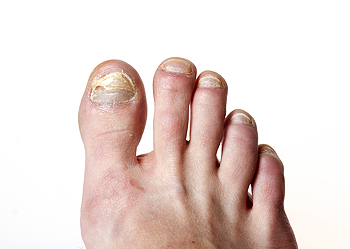
Onychomycosis is the medical term for toenail fungus. While different organisms may be responsible for the infection, dermatophytes are the most common culprits by far. Toenail fungus is a bothersome condition that causes the nails to become discolored, thickened, distorted, ragged, crumbly, brittle, and even smelly in certain cases. Older adults are more prone to contracting a toenail infection because as we age, our nails become more brittle. Brittle nails can crack, which can make it easier for the fungal organism to creep inside the nail and infect it. If you detect any of the symptoms mentioned here, it is advised to seek the care of a podiatrist. Toenail infections can be very difficult to treat at home, given that the organism can burrow deep into the multiple layers of the nail or underneath the nail, making it difficult to target and kill effectively and permanently. Also, home treatment may be risky for people with weakened immune symptoms, diabetes, or circulatory issues.
If left untreated, toenail fungus may spread to other toenails, skin, or even fingernails. If you suspect you have toenail fungus it is important to seek treatment right away. For more information about treatment, contact Glenn Davison, DPM of Advanced Podiatry. Our doctor can provide the care you need to keep you pain-free and on your feet.
Symptoms
Treatment
If self-care strategies and over-the-counter medications does not help your fungus, your podiatrist may give you a prescription drug instead. Even if you find relief from your toenail fungus symptoms, you may experience a repeat infection in the future.
Prevention
In order to prevent getting toenail fungus in the future, you should always make sure to wash your feet with soap and water. After washing, it is important to dry your feet thoroughly especially in between the toes. When trimming your toenails, be sure to trim straight across instead of in a rounded shape. It is crucial not to cover up discolored nails with nail polish because that will prevent your nail from being able to “breathe”.
In some cases, surgical procedure may be needed to remove the toenail fungus. Consult with your podiatrist about the best treatment options for your case of toenail fungus.
If you have any questions, please feel free to contact our offices located in Union, NJ and New York . We offer the newest diagnostic and treatment technologies for all your foot care needs.
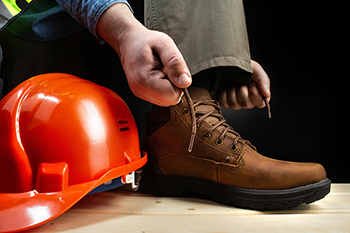
Hairdressers, restaurant line cooks and servers, teachers, and warehouse workers all have one thing in common—they spend a great part of their workday standing on their feet. This prolonged activity can result in chronic pain and discomfort in the feet, legs, and back. The first line of defense against foot pain caused from prolonged standing is proper footwear. Experts suggest shoes with a flatter heel that offer ample arch support. If you stand on hard surfaces, extra cushioning should be considered while choosing your shoes. Insoles or custom orthotics may be necessary to correct any ongoing conditions that may contribute to pain or fatigue. Shoes that breathe can help to prevent infections that thrive in moist environments. High heels should be avoided. It is also recommended that regular stretching exercises help blood circulate to the feet. Losing weight can reduce the pressure felt in the feet and legs, and it can help to keep joints healthy. Paying attention to your posture can aid in distributing your weight evenly and avoiding future leg and back problems. And finally, rest your feet when you can—taking breaks at work when possible and elevating them at home. If your foot pain becomes persistent, even when at rest, it is a good idea to consult a podiatrist for guidance and further treatment options.
While working on the feet, it is important to take the proper care of them. For more information about working on your feet, contact Glenn Davison, DPM from Advanced Podiatry. Our doctor will treat your foot and ankle needs.
Working on Your Feet
Standing on your feet for long periods of time can cause stress and pain in your feet. Your whole body may experience change in terms of posture, back pain, bunions, callouses and or plantar warts. There are ways to avoid these conditions with proper foot care, smart choices and correct posture.
Positive Changes
Negative heeled shoe – Choosing this shoe type places the heel slightly lower than the ball of the foot. These are great for overall foot health. Find shoes that fit you correctly.
Go barefoot – Our feet were not designed to be enclosed for all hours of the day. Try to periodically expose your feet to air.
Eliminate Pain
Foot Exercises – Performing simple exercises, incorporating yoga and doing stretches are beneficial. This will allow increased blood flow to the area and muscles of the foot.
Achilles tendon – Stretching the foot out flat on the floor will relax the calf muscles and tendon. These exercises can be performed almost anywhere. Make sure you add these exercises to your daily regimen.
With a little bit of this information and knowing more about foot health, you will notice changes. Foot stretches and proper footwear will help with pain and prevent further issues.
If you have any questions please feel free to contact our offices located in Union, NJ and New York . We offer the newest diagnostic and treatment technologies for all your foot and ankle needs.
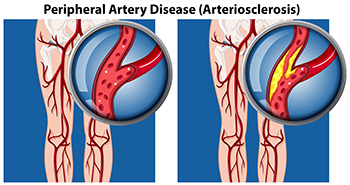
About 6.5 million people in the United States over the age of 40 have peripheral artery disease (PAD). It is a blockage in the arteries that supply blood to the extremities, but the condition is more common in the feet and lower limbs. Risk factors for peripheral artery disease include smoking, high blood pressure, diabetes, atherosclerosis, and high cholesterol. People over 60 are at further risk. The most common symptom of PAD is pain in the legs while active, but that subsides after resting. Sores in the legs or feet that don’t heal and cold or numb toes are other symptoms as well. If you believe you may have PAD, please consult a podiatrist for an examination and testing.
Peripheral artery disease can pose a serious risk to your health. It can increase the risk of stroke and heart attack. If you have symptoms of peripheral artery disease, consult with Glenn Davison, DPM from Advanced Podiatry. Our doctor will assess your condition and provide you with quality foot and ankle treatment.
Peripheral artery disease (PAD) is when arteries are constricted due to plaque (fatty deposits) build-up. This results in less blood flow to the legs and other extremities. The main cause of PAD is atherosclerosis, in which plaque builds up in the arteries.
Symptoms
Symptoms of PAD include:
It is important to note that a majority of individuals never show any symptoms of PAD.
Diagnosis
While PAD occurs in the legs and arteries, Podiatrists can diagnose PAD. Podiatrists utilize a test called an ankle-brachial index (ABI). An ABI test compares blood pressure in your arm to you ankle to see if any abnormality occurs. Ultrasound and imaging devices may also be used.
Treatment
Fortunately, lifestyle changes such as maintaining a healthy diet, exercising, managing cholesterol and blood sugar levels, and quitting smoking, can all treat PAD. Medications that prevent clots from occurring can be prescribed. Finally, in some cases, surgery may be recommended.
If you have any questions, please feel free to contact our offices located in Union, NJ and New York . We offer the newest diagnostic and treatment technologies for all your foot care needs.
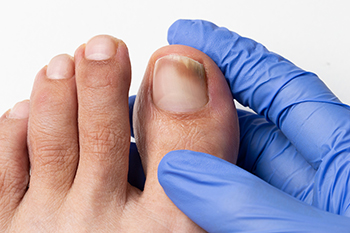
Toenail fungus is a noticeable foot condition. A toenail that is dark and thick can be caused by a fungus that is known as dermatophytes. The nail can change shape, and the color may differ as a result of the area which is affected underneath the nail. Many times, the nail on the big toe is the first to start developing toenail fungus, and in severe cases, it may travel to other nails. There may be existing medical conditions that can lead to toenail fungus. These can include diabetes, problems with circulation, or a weakened immune system. If this condition is not treated promptly, the nails may begin to crumble, and the fungus may grow under the nail, and possibly ooze. Effective treatment may take months to completely heal the fungus, and it is important to stay consistent with applying creams, and taking medication. A podiatrist can properly diagnose and treat this condition, and it is suggested that you schedule an appointment as soon as possible so the proper treatment can begin.
For more information about treatment, contact Glenn Davison, DPM of Advanced Podiatry. Our doctor can provide the care you need to keep you pain-free and on your feet.
Toenail Fungus Treatment
Toenail fungus is a condition that affects many people and can be especially hard to get rid of. Fortunately, there are several methods to go about treating and avoiding it.
Antifungals & Deterrence
Oral antifungal medicine has been shown to be effective in many cases. It is important to consult with a podiatrist to determine the proper regiment for you, or potentially explore other options.
Applying foot powder on the feet and shoes helps keep the feet free of moisture and sweat.
Sandals or open toed shoes – Wearing these will allow air movement and help keep feet dry. They also expose your feet to light, which fungus cannot tolerate. Socks with moisture wicking material also help as well.
If you have any questions please feel free to contact our offices located in Union, NJ and New York . We offer the newest diagnostic tools and technology to treat your foot and ankle needs.
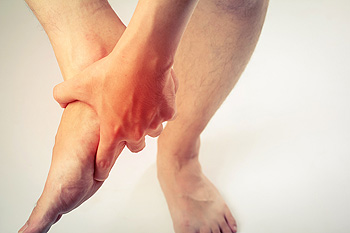
Bone spurs or osteophytes are smooth growths of bone that can develop throughout the body, over a long period of time. Common areas for such spurs to occur include heels, ankles, and big toes. They are a natural part of aging but also can be a progression of certain medical conditions, such as osteoarthritis. In fact, joint damage from osteoarthritis is the most frequent cause of bone spurs. Bone spurs are not painful in and of themselves but can become painful when they push into surrounding tissue and nerves. If there are no symptoms, bone spurs do not have to be treated, however, if they cause pain, treatment should be undertaken. Some common suggestions for alleviating the pain of foot bone spurs include maintaining a healthy body weight to take pressure off joints and doing exercises to stretch and strengthen muscles around joints, resting, and icing the affected area. Surgery may be needed to remove bone spurs if inflammation and pain become debilitating. If you have a troublesome bone spur on your foot, it is best to see a podiatrist to discuss the best treatment to alleviate your pain.
Foot Pain
Foot pain can be extremely painful and debilitating. If you have a foot pain, consult with Glenn Davison, DPM from Advanced Podiatry. Our doctor will assess your condition and provide you with quality foot and ankle treatment.
Causes
Foot pain is a very broad condition that could be caused by one or more ailments. The most common include:
Diagnosis
To figure out the cause of foot pain, podiatrists utilize several different methods. This can range from simple visual inspections and sensation tests to X-rays and MRI scans. Prior medical history, family medical history, and any recent physical traumatic events will all be taken into consideration for a proper diagnosis.
Treatment
Treatment depends upon the cause of the foot pain. Whether it is resting, staying off the foot, or having surgery; podiatrists have a number of treatment options available for foot pain.
If you have any questions, please feel free to contact our offices located in Union, NJ and New York . We offer the newest diagnostic and treatment technologies for all your foot care needs.
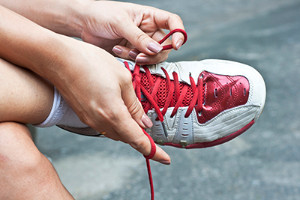
It’s not about the looks or the status, it’s about the fit. When in doubt, experts recommend that when shopping for running shoes to put fit over fashion, brand, or price. Shoes that are too tight can cause blisters, while shoes that are too wide can hurt your toes. Shoes that fit poorly can cause tendonitis, pinched nerves, heel pain, ankle sprains, and stress fractures. Signs that your shoes don’t fit properly include heel slippage, numbness on the top of the feet, and bruising on the toes. The best way to prevent these from occurring is to measure your feet while also wearing the socks you will use as you run. Check your foot measurements periodically, as foot size can change if you gain or lose weight. A rule of thumb is to have at least a half-inch of room between your toes and the end of the shoe. Running shoes usually run about half a size larger than street shoes, to allow for the feet to expand as you run. Try on several types of shoes before making a decision. If you need guidance on the best running shoe for you, please consult a podiatrist.
You should always make sure your running shoes fit properly in order to avoid injury. For more information, contact Glenn Davison, DPM from Advanced Podiatry. Our doctor can provide the care you need to keep you pain-free and on your feet.
Choosing the Right Running Shoe for Your Foot Type
Improper shoe sizing can cause a myriad of problems for your feet. Shoes that don’t fit you properly can lead to muscular imbalances in your body, which can result in foot, knee, and hip injuries.
Tips for Finding the Right Running Shoe
If you have any questions please feel free to contact our our offices located in Union, NJ and New York . We offer the newest diagnostic and treatment technologies for all your foot and ankle needs.
Putting your best foot forward means having healthy feet, which takes time and dedication. As a rule, it is important to keep your feet clean and dry, wear shoes that fit well and give proper support, and practice good foot hygiene. This includes such things as checking for abnormalities, cuts and sores on the skin, properly trimming toenails, removal of calluses, and moisturizing. But even healthy feet are subject to numerous problems, including plantar fasciitis (heel pain), bunions, plantar warts, ingrown toenails, athlete’s foot, corns and blisters. Common injuries include sprains, strains, stress fractures and broken bones. Several serious conditions, such as diabetes, peripheral artery disease, and different types of arthritis also can cause or contribute to foot problems, like swelling, redness, numbness, infections, ulcerous wounds and pain. Further, as you age and become more sedentary, minor foot problems can worsen. To ensure that your feet can take you where you want to go for many more years, it is a good idea to develop an ongoing relationship with a podiatrist who can help you deal with foot and ankle problems when they arise.
Everyday foot care is very important to prevent infection and other foot ailments. If you need your feet checked, contact Glenn Davison, DPM from Advanced Podiatry. Our doctor can provide the care you need to keep you pain-free and on your feet.
Everyday Foot Care
Often, people take care of their bodies, face and hair more so than they do for their feet. But the feet are a very important aspect of our bodies, and one that we should pay more attention to. Without our feet, we would not be able to perform most daily tasks.
It is best to check your feet regularly to make sure there are no new bruises or cuts that you may not have noticed before. For dry feet, moisturizer can easily be a remedy and can be applied as often as necessary to the affected areas. Wearing shoes that fit well can also help you maintain good foot health, as well as making it easier to walk and do daily activities without the stress or pain of ill-fitting shoes, high heels, or even flip flops. Wearing clean socks with closed shoes is important to ensure that sweat and bacteria do not accumulate within the shoe. Clean socks help to prevent Athlete’s foot, fungi problems, bad odors, and can absorb sweat.
If you have any questions please feel free to contact our offices located in Union, NJ and New York . We offer the newest diagnostic and treatment technologies for all your foot and ankle needs.
When your feet hurt, it is not easy to to do any form of exercise. However, it is thought that being active can actually help to reduce pain in the long run. If putting weight on your feet for any period of time is simply too painful, taking to the water might help. Exercising in a pool eliminates the pressure on your feet while allowing you to move other parts of the body. Applying ice to the sore areas of your feet is another way to reduce the pain. Taking non-steroidal anti-inflammatory medication, available over the counter, can also help. Devices such as canes, walking sticks, or walkers can absorb some of the weight placed on your feet when you stand or walk. Also, check that your footwear is comfortable, roomy, cushioned and supportive. Another key contributor to foot pain is being overweight, so the combination of a healthier diet and added exercise will likely be beneficial. If your pain increases or becomes unbearable, it’s a good idea to consult a podiatrist for a complete examination and diagnosis, as well as other treatment options.
Foot Pain
Foot pain can be extremely painful and debilitating. If you have a foot pain, consult with Glenn Davison, DPM from Advanced Podiatry. Our doctor will assess your condition and provide you with quality foot and ankle treatment.
Causes
Foot pain is a very broad condition that could be caused by one or more ailments. The most common include:
Diagnosis
To figure out the cause of foot pain, podiatrists utilize several different methods. This can range from simple visual inspections and sensation tests to X-rays and MRI scans. Prior medical history, family medical history, and any recent physical traumatic events will all be taken into consideration for a proper diagnosis.
Treatment
Treatment depends upon the cause of the foot pain. Whether it is resting, staying off the foot, or having surgery; podiatrists have a number of treatment options available for foot pain.
If you have any questions, please feel free to contact our offices located in Union, NJ and New York . We offer the newest diagnostic and treatment technologies for all your foot care needs.